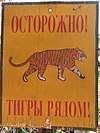Champawat Tiger
The Champawat Tiger was a Bengal tigress responsible for an estimated 436 deaths in Nepal and the Kumaon area of India, during the last years of the 19th century and the first years of the 20th century.[1] Her attacks have been listed in the Guinness Book of World Records as the highest number of fatalities from a tiger.[2] She was shot in 1907 by Jim Corbett.[3]
History
According to Peter Byrne, professional hunter and author from Nepal, the tiger began her attacks in a Rupal village in western Nepal, Himalayas.[4] Hunters were sent in to kill the tiger, but she managed to evade them. Eventually, the Nepalese Army was called in. Despite failing to capture or kill the tiger, soldiers organised a massive beat and managed to force the tiger to abandon her territory and drive her across the border (river Sarda) into India, where she continued her killing activities in the Kumaon District. All her kills happened during the daylight (as Corbett writes, he is not aware of a single case of a man-eating tiger killing a human during the night). Life across the region grew paralyzed, with men often refusing to leave their huts for work after hearing the tiger's roars from the forest.[5]
In 1907, the tiger was killed by British hunter Jim Corbett. The tiger had killed a 16-year-old girl, Premka Devi, in the village of Fungar,[6] near to the town of Champawat, and left a trail of blood, which Corbett followed. After the whole day pursuit, Corbett had to abandon the hunt, deciding to use villagers and to organize a beat the next day in the Champa River gorge.
With the help of the tehsildar of Champawat, the beat was organized with about 300 villagers, and the next day, about noon, Corbett shot the tigress dead.
A postmortem on the tigress showed the upper and lower canine teeth on the right side of her mouth were broken, the upper one in half, the lower one right down to the bone. This injury, a result of an old gunshot, according to Corbett, probably prevented her from hunting her natural prey, and hence, she started to hunt humans.[7]
Champawat town
In Champawat, near the Chataar Bridge and on the way to Lohaghat, there is a "cement board" marking the place where the tigress was finally brought down. The details about the Champawat Tigress and how she was brought down can be found in the book Maneaters of Kumaon (1944), written by Corbett himself.
Killing site
The information about the first victim of the tigress, as well as the photos of the overhanging rock at the Champa River, where the tigress was killed, can be seen in the book "Behind Jim Corbett's Stories" which is freely available on the internet.[8]
See also
References
- ↑ Tiger and leopard attacks in Nepal BBC News (11 July 2012)
- ↑ Young, Mark C.; Matthews, Peter; McWhirter, Norris (1997). "The Guinness Book of Records 1997". Guinness World Records. Bantam Books. ISBN 9780553576849.
- ↑ Stephen Mills (2004). Tiger. Firefly Books. p. 99. ISBN 978-1-55297-949-5. OCLC 57209158.
- ↑ Peter Byrne, Shikari Sahib, Safari Press, 2007
- ↑ "Top 10 Worst Man Eaters In History". Listverse.
- ↑ Premka Devi, the Last Victim of Champawat Man-Eater, by Preetum Gheerawo, from the book "Behind Jim Corbett's Stories" Logos, 2016
- ↑ Loadstar. "Man-eaters. The tiger and lion, attacks on humans".
- ↑ http://www.josephjordania.com/files/47-Corbert-book.pdf
Further reading
- Mills, Stephen (2004). Tiger. Firefly Books. ISBN 978-1-55297-949-5. OCLC 57209158.
- Corbett, Jim (1944). Man-Eaters of Kumaon. Bombay: Oxford University Press.
- Mason, Paul (2007). The world's most dangerous animals. Chicago: Raintree. ISBN 978-1-4109-2485-8.
- Mishra, Hemanta; Ottaway, Jr, Jim (2010). Bones of the Tiger: Protecting the Man-Eaters of Nepal. Globe Pequot. ISBN 978-1-59921-491-7.
